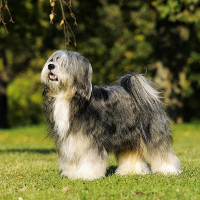 |
Tibetan Kyi Apso |
|
He is not recognized by the F.C.I. |
Origin |
Tibet | |
Translation |
Francis Vandersteen | |
This breed is also known as |
Kyi Apso
|
| The Tibetan Kyi Apso, also known as the Apso Do-Kyi, is a rare Tibetan breed of cattle dog. In Tibet, Pashmina from this breed is sometimes rescued and used to weave small rugs. In Tibetan, "kyi" means dog and "apso" is an abbreviation of "ara" meaning moustache and "sog-sog" meaning hairy. It is also referred to in common parlance as a type of "do-khyi", meaning a dog that is tied up. These large, mischievous dogs are recognized by their long coats, fully curved tails and "bearded" faces. This breed measures between 61 and 71 centimeters and weighs just under 45 kilos. Compared with the Tibetan Mastiff, the Kyi Apso has a bearded, bushy muzzle and longer hair overall, but is not as heavy-boned. Most Kyi Apsos look lighter and more athletic than a Tibetan Mastiff, and flex lips, dewlaps, facial wrinkles, or lots of huge, sagging ears. Considered a primitive breed, it generally retains the hardiness it would need to survive in Tibet and the high-altitude Himalayan range. Instinctive behaviors, including canine pack behavior, have contributed to the breed's survival in harsh environments. It is one of the few primitive dog breeds that retains a single estrus per year instead of two, even at much lower altitudes and in climates much more temperate than its native climate. This characteristic is also found in wild canids such as wolves and other wild animals. The dogs are also going through a period of turmoil associated with the traditional yak migrations in Tibet. This creates a tendency for these dogs to want to roam periodically. Their double coat is long, subject to the climate, and comes in a wide variety of colors, including solid black, black and beige, various shades of "red" (from pale gold to deep red) and bluish gray (diluted black), often with white markings. It also lacks that unpleasant "big dog" smell that afflicts many large breeds. The coat, whatever its length or color, should eliminate dirt and odors. Although dogs shed a little throughout the year, there's usually a big "shed" in late winter or early spring, and sometimes a smaller one in late summer or early fall. (Neutering a dog can dramatically affect the coat in terms of texture, density and type of shedding). Among the few dogs that have made it to the West, temperament can be described as generally relaxed, affectionate and peaceful, but they are also very assertive in defending their territory. They seem to be less serious than the Tibetan Mastiff, approaching life with a little more whimsy and humor. They can become deadly serious if the situation warrants, but they don't sweat the small stuff. As herding dogs in Tibet and the West, they use all the usual herding tactics (e.g. barking, scent-marking perimeters) to warn off predators and avoid direct confrontation. The first mention of this breed of dog comes from 19th and early 20th century writings on the dogs of Central Asia, Tibet and the Himalayan countries. It is related to the Tibetan Mastiff. Captain George Augustus Graham, better known among dog lovers as the founder of Britain's Irish Wolfhound Club, imported a dog called a "Tibetan Wolfhound". This dog is best described as a Kyi Apso. The 13th Dalai Lama is known to have owned a dog of this type. Relatively few Tibetan Kyi Apsos have reached North America or Europe. The first were imported to North America in the late 1970s, or perhaps earlier, but none of these dogs appear to have left any offspring. The breed was well represented and nurtured by the now defunct Kyi Apso Tibetan Club, founded in 1995, but collapsed in 1999 and registered no litters after 2000. |






 English (United Kingdom)
English (United Kingdom)